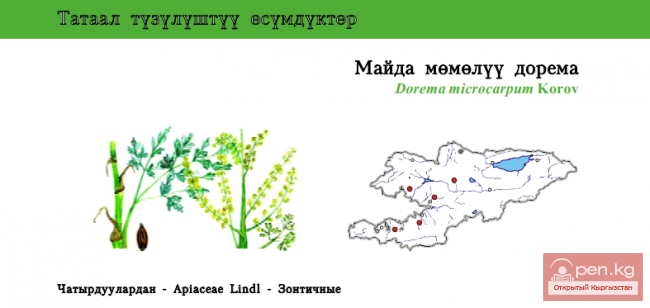
Chesneya villosa Status: EN. One of the three very rarely encountered species of this genus in...

Kaufmannia Semenova Status: VU. Endemic, rare species....

Alai Bubblewort Status: VU. A rare narrowly endemic species....

html Lamyropappus schakaptaricus Status: VU. A rare representative of a monotypic genus....

Rhodiola litwinowii Status: LC. A mosaic-distributed species, intensively used in agriculture....

Large-calyxed Primrose Status: VU. In Kyrgyzstan, it is a very narrowly distributed, rare,...

False Hooked Fumitory Status: VU. Endemic species of the Pamir-Alai....

Olga’s Sorbaria Status: CR B2ab(iii). A rare narrow-endemic species of the Alai Mountain Range....

Eugenia’s Bell-flower Status: VU. Endemic to the Western Tien Shan (Talas and Fergana Ranges). A...

Incarvillea olgae Status: CR B2ab(iii). A very rare, critically endangered ancient species...

Edelweiss-like Pyrethrum Status: VU. Endemic species....

Catmint-like Scullcup Status: VU. A very rare narrowly endemic species. Ornamental plant....

Eugenia's Primrose Status: VU. A narrow endemic rare, highly ornamental species. Found in...

Alai Centaury Status: VU. Endemic species....

Aulie-Ata Stemmacantha Centaury Status: EN. A very rare species, critically endangered....

Eremurus zoae Status: VU. A narrowly endemic species of the Kyrgyz Range....

Short-winged Bladder-senna Status: VU. One of three very rarely occurring species of this genus in...

Andrachne-like Scullcup Status: VU. A very rare rocky species, narrowly endemic to a small section...

Twelve-dentate Onion Status: VU. A narrowly endemic species of the Chatkal Ridge. Description. A...

Iskandera Alai Status: VU. A very rare narrow endemic species. There is only one species of this...

Kostychev’s Pascueflower Status: VU. A narrowly endemic and very beautiful plant, deserving...

Dorema microcarpum Status: VU. Rare endemic species....

Persian Rowan Status: VU. Endemic, ornamental species....

Regel’s Eminium Status: VU. A rare endemic species of the Western Tien Shan....

html Korshinsky’s Meadow Saxifrage Status: EN. A rare endemic species found in small numbers and...

Eremurus Zenaidae Status: VU. Endemic to the lower and middle belts of the Fergana and Alai...

Wolly-fruited Kosopoljanskia Status: EN. Endemic. One of the two species that are sub-endemic to...

Schennikov’s Otostegia Status: VU. A rare endemic species, endemic to Kyrgyzstan with a disjunct...

Semenov’s Onion Status: VU. Endemic to the Inner Tien Shan....

Sclerotiaria pentaceros Status: CR B2ab(iii). Endemic to a monotypic genus....

Broad-stamened Tulip Status: VU. A narrow endemic of the Alai Ridge....

Vvedensky’s Sage Status: VU. A very rare narrowly endemic species. An ornamental plant....

Tien Shan Sibiraea Status: CR. An endemic, decorative, and rare northern Tien Shan plant....

Anomalous Alajja (Erianthera anomala) Status: VU. Endemic to the mountains of Central Asia. A rare...

Korolkov’s Sage Status: VU. A rare narrow endemic species. A highly decorative plant....

Wrapped Alpine Saw-wort Status: VU. Rare species. Found in Kyrgyzstan at the edge of its range....

Golden Trichanthemis Centaury Status: VU. A rare narrowly endemic species of the Alai Ridge, an...

Kolyuchelistnik kachimovidny Status: VU. A species with a rapidly reducing range. The roots of...

Quadrifolious Tulip Status: VU. Endemic to the Inner Tien Shan....

Acantholimon compactum Status: VU. A very rare narrowly endemic species....

Hairy Flowering Plant Aulie-Ata Status: EN. A representative of a monotypic section, a narrowly...

Kashgarian Barberry Status: VU. Rare species....

All elements and conditions, as well as phenomena and bodies of nature, can be used in public...